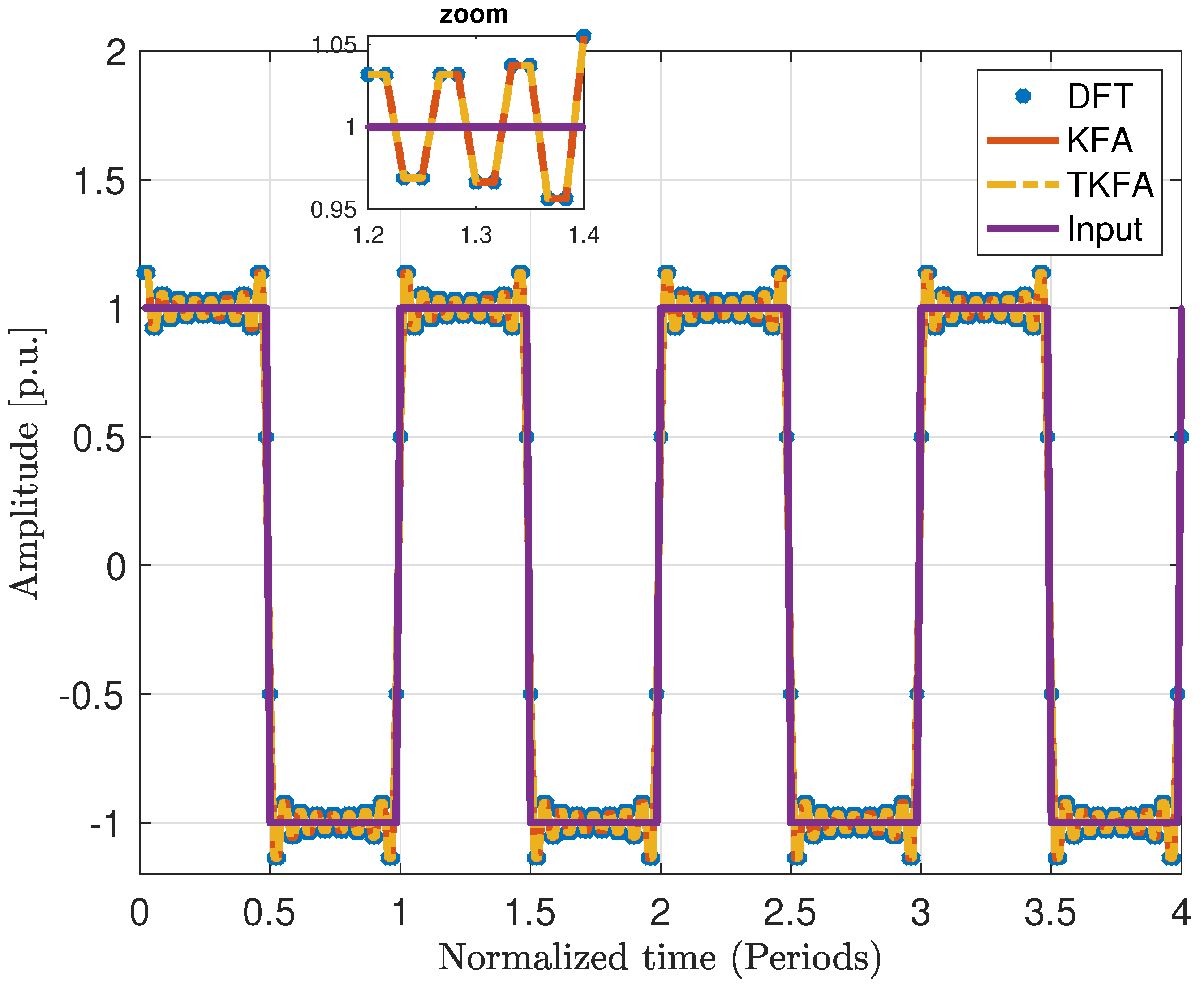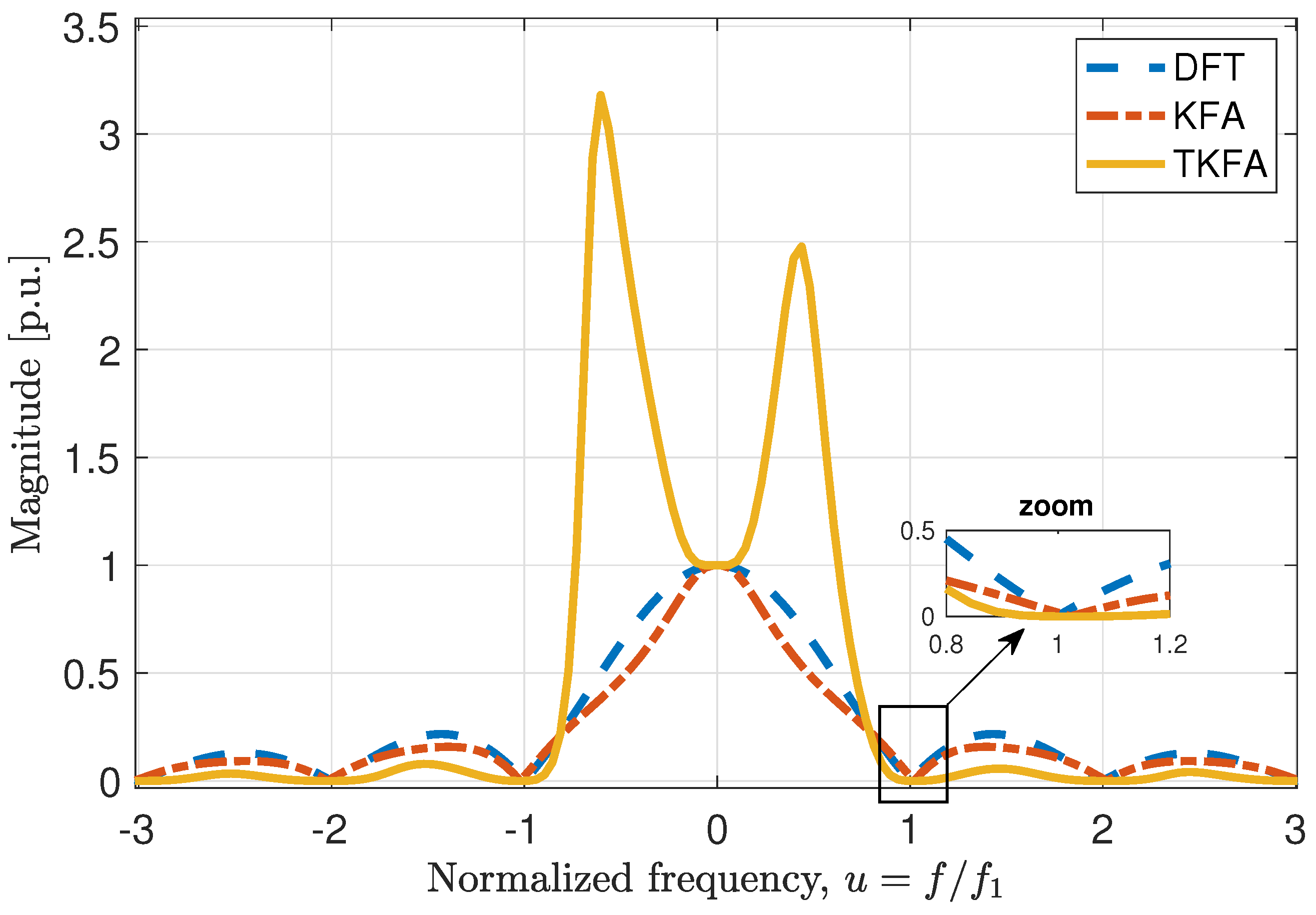Alternative Method to Estimate the Fourier Expansions and Its Rate of Change
Abstract
1. Introduction
2. The Spectral Observer Approach
| , | , | ; |
| , | , | ; |
| ; | ||
| ; | ||
| ; | ||
3. The Kalman Filter Applied and Coefficient Estimates
3.1. Kalman Filter Algorithm (KFA)
3.2. Taylor–Kalman–Fourier Algorithm (TKFA)
| Algorithm 1 Pseudocode of the Kalman filter algorithm. |
| 1: procedure |
| 2: –Inputs |
| 3: Input current signal for up to , |
| 4: Guess initial internal variables, |
| 5: Guess initial frequency, |
| 6: Guess initial covariance, |
| 7: Variance of process noise, |
| 8: Variance of measurement noise, |
| 9: Signal model parameters, |
| 10: for to do |
| 11: –State prediction |
| 12: , |
| 13: , |
| 14: –Measurement update |
| 15: , |
| 16: , |
| 17: , |
| 18: end for |
| 19: end procedure |
3.3. Coefficients and Signal Approximation
| Algorithm 2 Pseudocode to coefficient estimates and signal approximation. |
| 1: procedure |
| 2: –Inputs |
| 3: 0, Initial value, |
| 4: 0, Initial value, |
| 5: for to ℓ do, |
| 6: , |
| 7: , |
| 8: , Compute (18a), |
| 9: , Compute (18b), |
| 10: , Compute (18c), |
| 11: end for |
| 12: end procedure |
4. Performance of the Harmonic Filters
5. Conclusions
Author Contributions
Funding
Data Availability Statement
Acknowledgments
Conflicts of Interest
References
- Saima, S.; Li, B.; Adnan, S.M. New Sampling Expansion Related to Derivatives in Quaternion Fourier Transform Domain. Mathematics 2022, 10, 1217. [Google Scholar] [CrossRef]
- Ruibo, J.; Xiaoqiang, L. Using Fourier series to fit The GPS precise ephemeris. In Proceedings of the 2010 International Conference on Computer Application and System Modeling (ICCASM 2010), Taiyuan, China, 22–24 October 2010; Volume 11, pp. V11-96–V11-99. [Google Scholar] [CrossRef]
- Labiod, S.; Boubertakh, H.; Guerra, T.M. Fourier series-based adaptive tracking control for robot manipulators. In Proceedings of the 3rd International Conference on Systems and Control, Algiers, Algeria, 29–31 October 2013; pp. 968–972. [Google Scholar] [CrossRef]
- Gholipour, R.; Fateh, M.M. Adaptive task-space control of robot manipulators using the Fourier series expansion without task-space velocity measurements. Measurement 2018, 123, 285–292. [Google Scholar] [CrossRef]
- Van den Bos, A. Best linear unbiased estimation of the Fourier coefficients of periodic signals. IEEE Trans. Instrum. Meas. 1993, 42, 49–51. [Google Scholar] [CrossRef][Green Version]
- Harris, F.J. On the use of windows for harmonic analysis with the discrete Fourier transform. Proc. IEEE 1978, 66, 51–83. [Google Scholar] [CrossRef]
- Hostetter, G. Recursive discrete Fourier transformation. IEEE Trans. Acoust. Speech Signal Process 1980, 28, 184–190. [Google Scholar] [CrossRef]
- Varkonyi-Koczy, A.R. A recursive fast Fourier transformation algorithm. IEEE Trans. Circuits Syst. II Analog Digit. Signal Process 1995, 42, 614–616. [Google Scholar] [CrossRef]
- Fan, C.P.; Su, G.A. Novel recursive discrete Fourier transform with compact architecture. In Proceedings of the 2004 IEEE Asia-Pacific Conference on Circuits and Systems, Tainan, Taiwan, 6–9 December 2004; Volume 2, pp. 1081–1084. [Google Scholar] [CrossRef]
- Park, S.H.; Kim, M.J.; Kwon, W.H.; Kwon, O.K. Short-time harmonic analysis via the state-space optimal FIR filter. In Proceedings of the SICE ’95, 34th SICE Annual Conference, Hokkaido, Japan, 26–28 July 1995; International Session Papers. pp. 1205–1210. [Google Scholar] [CrossRef]
- Park, S.H.; Kwon, W.H.; Kwon, O.K.; Kim, M.J. Short-time Fourier analysis via optimal harmonic FIR filters. IEEE Trans. Signal Process 1997, 45, 1535–1542. [Google Scholar] [CrossRef]
- Li, W. Alternative Fourier Series Expansions with Accelerated Convergence. Appl. Math. 2016, 7, 1824–1845. [Google Scholar] [CrossRef]
- Xiao, Y.; Tadokoro, Y.; Shida, K. Adaptive algorithm based on least mean p-power error criterion for Fourier analysis in additive noise. IEEE Trans. Signal Process 1999, 47, 1172–1181. [Google Scholar] [CrossRef]
- Nishi, K. Kalman filter analysis for quasi-periodic signals. In Proceedings of the 2001 IEEE International Conference on Acoustics, Speech, and Signal Processing, Proceedings (Cat. No.01CH37221), Salt Lake City, UT, USA, 7–11 May 2001; Volume 6, pp. 3937–3940. [Google Scholar] [CrossRef]
- Gruber, P.; Todtli, J. Estimation of quasiperiodic signal parameters by means of dynamic signal models. IEEE Trans. Signal Process 1994, 42, 552–562. [Google Scholar] [CrossRef]
- Kim, T.; Kim, D.; Jang, L.C.; Jang, G.W. Fourier Series for Functions Related to Chebyshev Polynomials of the First Kind and Lucas Polynomials. Mathematics 2018, 6, 276. [Google Scholar] [CrossRef]
- Sefusatti, E.; Crocce, M.; Scoccimarro, R.; Couchman, H.M.P. Accurate estimators of correlation functions in Fourier space. Mon. Not. R. Astron. Soc. 2016, 460, 3624–3636. [Google Scholar] [CrossRef]
- Gilbert, A.C.; Guha, S.; Indyk, P.; Muthukrishnan, S.; Strauss, M. Near-Optimal Sparse Fourier Representations via Sampling. In Proceedings of the Annual ACM Symposium on Theory of Computing, Montreal, QC, Canada, 19–21 May 2002; pp. 152–161. [Google Scholar] [CrossRef]
- Yu, W.; Yong, Y.; Guan, G.; Huang, Y.; Su, W.; Cui, C. Valuing Guaranteed Minimum Death Benefits by Cosine Series Expansion. Mathematics 2019, 7, 835. [Google Scholar] [CrossRef]
- Bitmead, R.; Tsoi, A.; Parker, P. A Kalman filtering approach to short-time Fourier analysis. IEEE Trans. Acoust. Speech Signal Process 1986, 34, 1493–1501. [Google Scholar] [CrossRef]
- Zhang, B.; Pong, M.H. Dynamic model and small signal analysis based on the extended describing function and Fourier series of a novel AM ZVS direct coupling DC/DC converter. In Proceedings of the Power Processing and Electronic Specialists Conference, Atlantic City, NJ, USA, 22–23 May 1997; Volume 1, pp. 447–452. [Google Scholar] [CrossRef]
- Manolakis, D.G.; Ingle, V.K.; Kogon, S.M. Statistical and Adaptive Signal Processing: Spectral Estimation, Signal Modeling, Adaptive Filtering and Array Processing; Artech House Publishers: Boston, MA, USA, 2005. [Google Scholar]
- Simon, D. Optimal State Estimation: Kalman, H Infinity, and Nonlinear Approaches; John Wiley & Sons: Hoboken, NJ, USA, 2006. [Google Scholar]
- Trujillo-Guajardo, L.A.; Rodriguez-Maldonado, J.; Moonem, M.A.; Platas-Garza, M.A. A Multiresolution Taylor–Kalman Approach for Broken Rotor Bar Detection in Cage Induction Motors. IEEE Trans. Instrum. Meas. 2018, 67, 1317–1328. [Google Scholar] [CrossRef]






| RMSE | ||||||||
|---|---|---|---|---|---|---|---|---|
| DFT | KFA | TKFA | DFT | KFA | TKFA | |||
| Square signal | ||||||||
| Sawtooth Signal | ||||||||
Publisher’s Note: MDPI stays neutral with regard to jurisdictional claims in published maps and institutional affiliations. |
© 2022 by the authors. Licensee MDPI, Basel, Switzerland. This article is an open access article distributed under the terms and conditions of the Creative Commons Attribution (CC BY) license (https://creativecommons.org/licenses/by/4.0/).
Share and Cite
Rodríguez-Maldonado, J.; Posadas-Castillo, C.; Zambrano-Serrano, E. Alternative Method to Estimate the Fourier Expansions and Its Rate of Change. Mathematics 2022, 10, 3832. https://doi.org/10.3390/math10203832
Rodríguez-Maldonado J, Posadas-Castillo C, Zambrano-Serrano E. Alternative Method to Estimate the Fourier Expansions and Its Rate of Change. Mathematics. 2022; 10(20):3832. https://doi.org/10.3390/math10203832
Chicago/Turabian StyleRodríguez-Maldonado, Johnny, Cornelio Posadas-Castillo, and Ernesto Zambrano-Serrano. 2022. "Alternative Method to Estimate the Fourier Expansions and Its Rate of Change" Mathematics 10, no. 20: 3832. https://doi.org/10.3390/math10203832
APA StyleRodríguez-Maldonado, J., Posadas-Castillo, C., & Zambrano-Serrano, E. (2022). Alternative Method to Estimate the Fourier Expansions and Its Rate of Change. Mathematics, 10(20), 3832. https://doi.org/10.3390/math10203832








